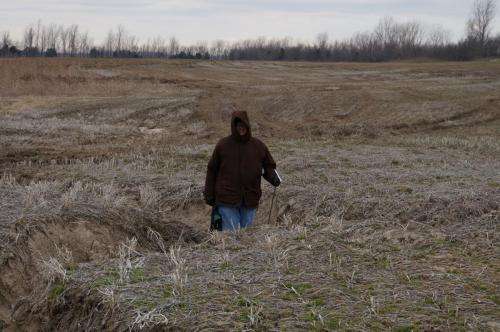U of I soil scientist Ken Olson measuring agully at O'Bryan Ridge. Credit: University of Illinois
When levees fail, either naturally or as an intentional breach, as was the case on the Mississippi River in 2011, an orchestrated effort is made to remove or repair flood-damaged homes and other structures. A University of Illinois soil scientist believes that an equivalent effort should be coordinated to assess soil damages, including how flooding has affected soil productivity and land used for agriculture.
"The United States Army Corps of Engineers, the Mississippi River Commission, and the USDA Natural Resource Conservation Service should develop an agreement to immediately update the soil survey maps, conduct a land scouring and deposition survey (commonly done now by USDA, NRCS), and create a soil conservation plan to ensure a rapid federal response after every levee breach and subsequent flooding event," said Ken Olson.
"This should be part of the federal government emergency response to a natural disaster. Disaster and emergency relief funds are now being used for restoration and repair work, including opening drainage and road ditches by removing sediment, levee repairs, crater lake filling, restoration of land-scoured areas adjacent to the levee breaches, and sand deposit removal from fields next to the crater lakes."
Olson led a team of scientists in a study of a 195-acre O'Bryan Ridge gully field area in Missouri and found that the area suffered a permanent loss of 30 percent of its agricultural productive capacity.
After reclamation in spring of 2013, the middle and lowest parts of the gullies were still not suitable for row crops. In spring of 2014, many of the ponds were drained, additional ridgetop topsoil and subsoil were used to fill in more of the gullies, which reduced the sloping acreage. More of the field was returned to soybean production each year but with significantly lower soybean yield potential.
Olson said that if the soil survey is immediately updated after every levee breach and subsequent flooding event the damage assessment will help agency technical staff, local leadership, and farmers. They would then have the information they need to make decisions and develop strategies to return the gully field lands to agricultural production or alternative land uses and to address future flood events.
"With the increase in extreme weather events, there is an increased likelihood of future use of the New Madrid Floodway to manage Mississippi River flooding," Olson said. "The soil damages and gully fields on O'Bryan Ridge will happen again and require more costly restoration."
Olson cautioned that the current repair and restoration efforts are restoring some of the lost soil productivity and production capacity but restoration efforts won't prevent a repeat of the 2011 soil damages.
"The new farmland that was created is either too erosive or too low in soil productivity and is no longer suited to continuous soybean production without conservation practices and a crop rotation," Olson said. "A terrace system and contour farming with grassed waterways will likely be needed to retain production under continuous soybean on any remaining sloping lands on the tract."
Olson added that no-till management doesn't provide a mechanical method to eliminate annual rills, which can quickly turn into new gullies—as happened in 2013. Planting cover crops after row crops could make the soil less vulnerable to future flooding and subsequent water erosion, as well as offer the added benefit of sequestering soil organic carbon.
"Ironically, if the 195-acre gully field on O'Bryan Ridge had grassed waterways on the sloping soils, had been planted to winter wheat in the fall of 2010, or if the soybean field had a cover crop and/or forages when the flooding occurred in May of 2011, the land scouring and gully formation would have been greatly diminished," Olson said.
More information: "Impact of levee breaches, flooding, and land scouring on soil productivity" was written by Kenneth Olson, Jeffrey Matthews, Lois Wright Morton, and John Sloan and published in the Journal of Soil and Water Conservation. www.jswconline.org/content/70/1/5A.full.pdf+html.
The O'Bryan Ridge case study is also summarized in the paper "Addressing soil degradation and flood risk decision making in levee protected agricultural lands under increasing variable climate conditions published by the Journal of Environmental Protection. The full text of the paper is available at: www.ngrrec.org/uploadedFiles/P … 2014092414545508.pdf.
Journal information: Journal of Soil and Water Conservation
Provided by University of Illinois at Urbana-Champaign
























